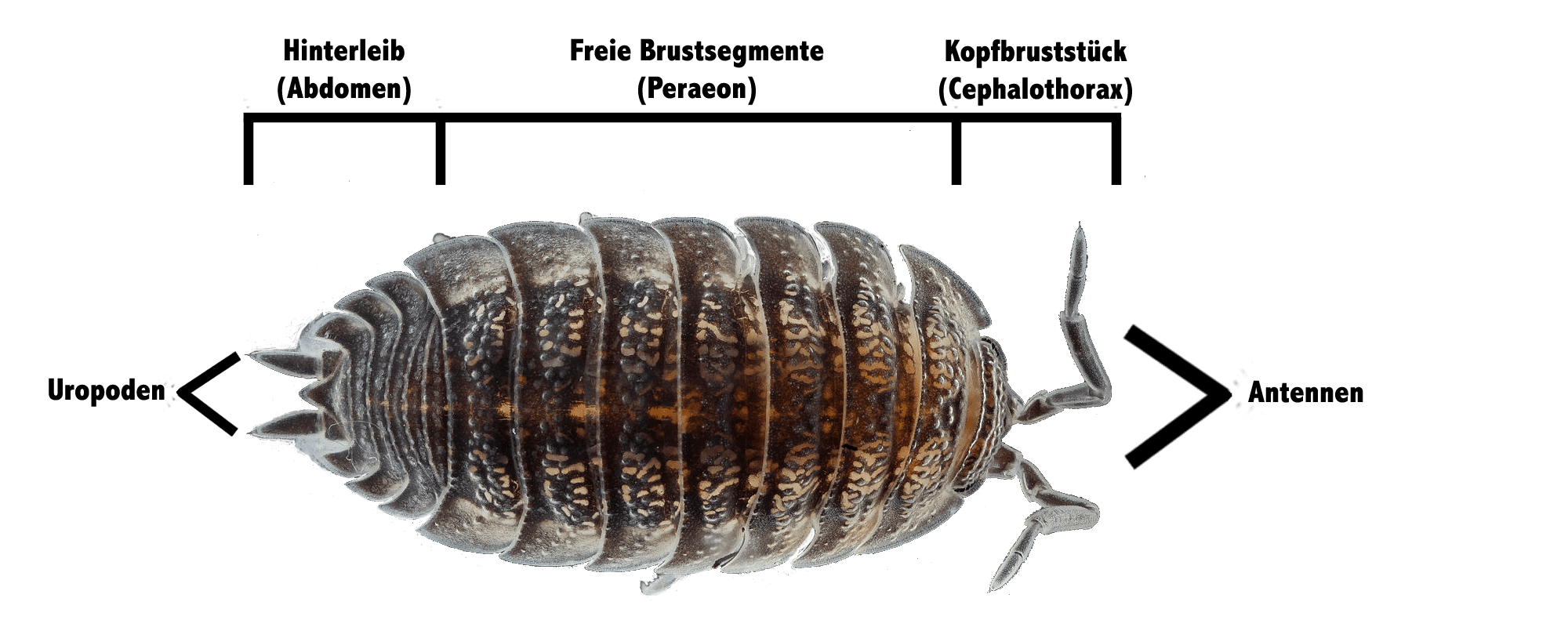We know isopods as gray-brown animals that are about 2 cm in size. They belong to the class of crustaceans or crustaceans and are the only representatives of this group that in the course of the earth’s history have changed from living in the water to living on land.
Woodlice have 7 pairs of similar legs and are therefore also called isopods:
- isos (griech.) = same
- podos (griech.) = Foot
This order includes species that live exclusively in water. Woodlice, on the other hand, have fully adapted to life on land. However, these so-called terrestrial isopods mostly require relatively high humidity.
The closest relatives of isopods are other crustaceans such as shrimps, crabs and lobsters. The external characteristic of these crustaceans is their armor-like exoskeleton.
The closely related class of insects also has such an exoskeleton, but it is clearly divided into three parts.
A characteristic feature of isopods is their armor-like exoskeleton with relatively broad, belt-like dorsal shields. It consists of chitin with calcium deposits, which makes it particularly robust. The mostly flattened body consists of several segments and can be divided into three sections, which, however, are not clearly separated from each other.
The last segment, the so-called tail plate, tapers to a point and has no pair of extremities. However, it carries a pair of limbs, the so-called uropods, on the side, as can be seen very nicely in the illustration. These serve as tail fan and tax in the aquatic isopods, and as tactile organ in our terrestrial species.
Most terrestrial isopods are separately sexed. In both sexes the sexual organs open on the ventral side. After mating, the females molt and develop, as can be seen very nicely in the illustration, a brood pouch (marsupium) between the first and the fifth pair of walking legs, in which the eggs are deposited and remain there especially protected until hatching.
After leaving the brood pouch, the young are significantly smaller and also lighter in color than the adults. Their carapace is soft, making them particularly sensitive to dryness and moisture at this stage. After a double moult, which also takes place in young isopods in two phases, the adult appearance is reached.
Woodlice are not exactly gourmets. They feed on leftovers which have to be decomposed to humus. Since the food is only incompletely digested in the intestine, the isopods eat their own feces, which contain a lot of cellulose and lignin, several times in order to further utilize the nutrients contained therein. This may not sound very appetizing, but it is extremely effective!
Among other things, mineral soil particles are ingested with the food, which are mixed with organic substances in the intestine and excreted as clay-humus complexes. Thus isopods are significantly involved in improving soil quality.
Although isopods possess powerful mouthparts with which they could crush fresh plant material and wood, they prefer dead, moist and already slightly microbially pre-decomposed material. They readily accept dead wood and foliage, but also lichens growing on bark are gratefully eaten. Most terrestrial isopods inhabit the soil surfaces and live in the litter layer. Only a few very small species, can colonize the mineral soil and have a distinct ability to burrow. Furthermore, the lime content of the soil plays a role in the distribution of isopods. Since isopods require lime for the consolidation of their exoskeleton, acidic soils without exchange lime are rarely colonized by isopods.
Woodlice, like all crustaceans, breathe through gills. Under their skeletal plates they carry a supply of fluid, which they use to breathe like aquatic creatures with gill-like organs. These are located on the ventral abdominal hind feet of the abdomen. Thus, terrestrial isopods depend on adequate moisture.
In the terrestrial isopod species that also penetrate drier locations, a special water conduction system has evolved that directs every drop of water that reaches the body surface to the gills. The water is sucked in capillary through the furrows between the body segments on the back and directed to the ventral side. There, the water is transported to the gills on the abdominal feet via ventral grooves that run between the walking leg joints.
As the moisture content of the air decreases, gill respiration is no longer sufficient. Thus, so-called “makeshift lungs” have developed on the inside of the abdominal feet through furrows and severe thinning of the skin, with which the terrestrial isopods can also take in oxygen from the air. For air breathing they bend their abdomen upwards, so that the air can reach the abdominal feet unhindered. The “used” air is expelled by curving the abdomen downward.



